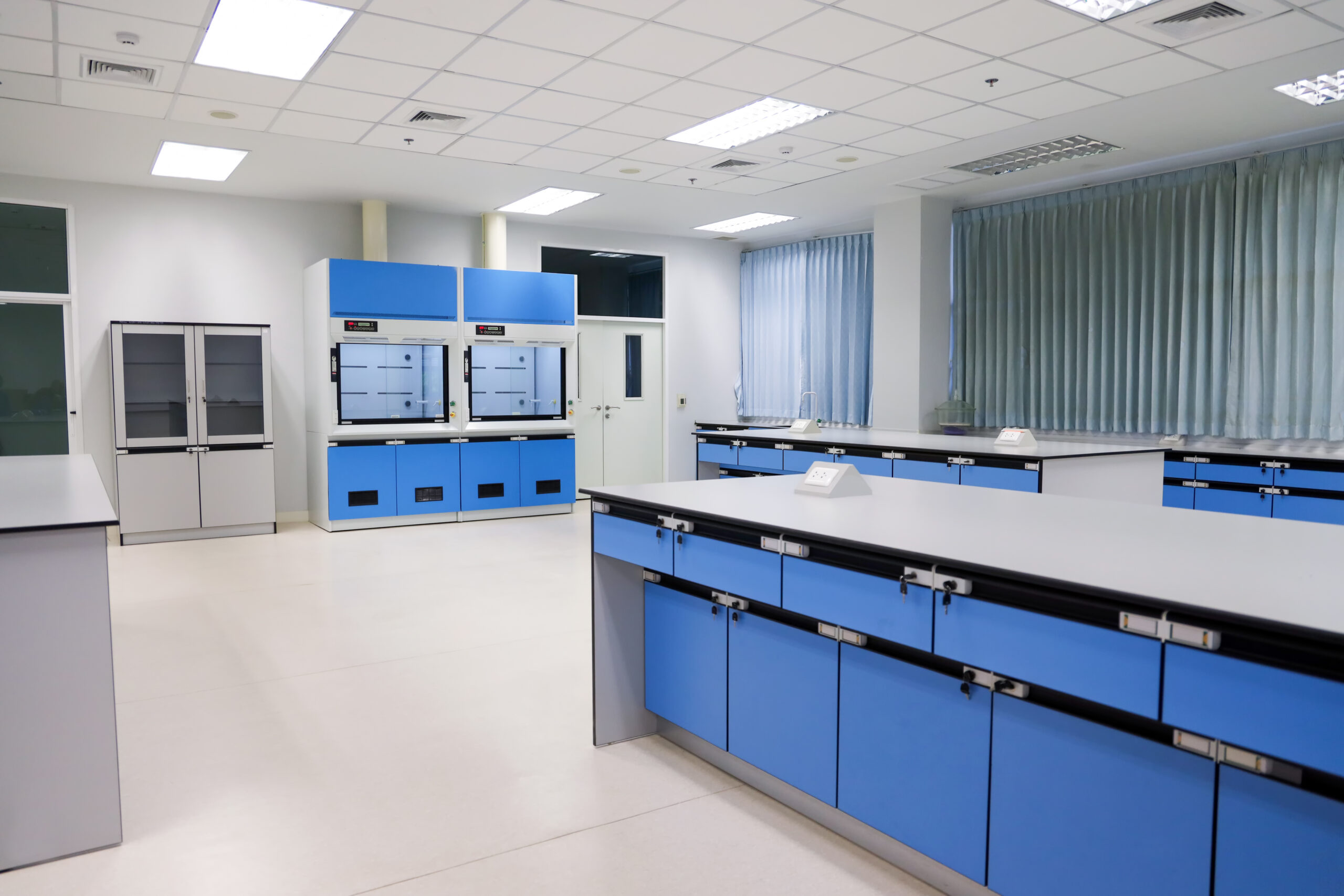
© Adobe Stock, settapong
Design and furnishing solutions for a functional and efficient lab space not only benefit students but allow staff to flourish too.
Check out our full Term 2 issue here.
As exciting as the hands-on experiments are, the need for notetaking, textbook reading, and diagram drawing must be factored alongside sufficient desk and bench space.
Students and staff need room to move, adequate seating, as well as digital or other display tools for visibility. Visualising a diagram is as important as seeing a liquid turn to gas: careful design is required to ensure presentations are visible from a distance without compromising safety.
Lab Equipment
While due care and diligence should always be taken, particularly at the design stage, students’ learning should not feel restricted by an overzealous approach to health and safety.
There are general science items that will be used regularly in practical lessons, so it is important to ensure that you have enough of each item to cover every student, including additional pieces to factor for any breakages that may occur.
These essential items include flasks, clamps, burners, forceps, gauze wire, teat pipettes, funnels, scissors, tripods, bench mats, test tubes, beakers, stirring rods, thermometers, and litmus paper.
For biology, for example, it is essential that you are stocking up on items such as: scalpels, petri dishes, microscopes, microscope slides and tongs. Whereas for chemistry classes, you’ll need to factor in the periodic table poster, chemicals, and components for use in experiments (e.g., magnesium strips), spill kits and hazardous material cabinets.
Chemical Storage Safety
Schools typically stock a mix of Class 3 (flammable liquids) and Class 8 (corrosives – e.g., acids) chemicals for demonstrations. Dangerous goods cabinets provide an effective solution for storage of these, as they deal with the main compliance issues from the relevant standards (e.g., bunding, shelf air movement, labelling, materials, and a degree of fire safety) all within one cabinet.
Connecting these to an exhaust fan system is possible to reduce and eliminate smells or fumes in the room. Cabinets can be tailored to your space, usually in a dedicated science preparation/storage room.
There are several options when it comes to fume cupboards such as four-sided, double-sided, side windowed, ducted, and ductless. All built-in fume cupboards must comply with AS/NZS 2243.8:2014 under the building code and need to be tested annually for compliance on the building’s BWOF as a Specified System (SS11).
Mobile or recirculating fume cabinets have their own Standard AS/NZS 2243.9 (2009). These do not require annual inspection by a qualified person, but the standard does provide a template for annual testing/inspection, nonetheless.
Flammables cabinets (Class 3) must comply with (part) AS 1940:2017 or EN 14470-1:2004 according to the Health & Safety at Work Regulations (2017) 11.29. The European (EN) standard provides for fire safety ratings in the cabinet and allows for different labelling. Containers must store less than 20 litres each in these cabinets, and the total stored cannot exceed 250 litres. Corrosives Cabinets (Class 8) must comply with (part) AS 3780:2008 “or a standard in a relevant safe work instrument” according to the Health & Safety at Work Regulations (2017) 13.37. Storage volumes are limited to 1000 L or kg total (less for some subclasses), but schools typically store much less.
High quality, durable materials should be incorporated into a well-considered, smartly designed science space. And while the investment can appear daunting, providing a quality science environment that will stand the test of time, can ensure many years of fostering high achieving scientists, engineers, and technicians – and that’s just the staff!
Science Lab Supplier Insights
“School laboratories often use recirculating (ductless) fume cabinets. They are convenient and versatile for demonstrations, but they do have limitations that must be recognised so they can be operated in a safe and responsible manner. The applicable standard is AS/NZS2243.9 and the recommendations in this standard are there to ensure users and students are working in a safe and healthy environment.
“Each fume cabinet must have its own logbook. This should be used to record that dates and times that the cabinet is used as well as the chemicals and volumes used. It should show the filter change dates.
“A copy of the fume cabinet location and spacing requirements diagram from the standard must be kept with each fume cabinet to ensure compliance when the cabinet is moved. Each time the fume cabinet is moved to a new location, a commissioning test shall be carried out, including airflow tests and smoke tests. This will ensure there are no issues with air movements that could disturb the fume cabinet’s containment. A record of all commissioning tests shall be kept and accessible for inspections.
“If a recirculating fume cabinet does not have an automatic air flow alarm and filter saturation alarm, it must be tested for both airflow and filter performance every month. The standard also requires that any person who operates a recirculating fume cabinet is competent, has been instructed in its use and is fully aware of the limitations.
“There are many more aspects to the safe use of this equipment that schools should be aware of and the information above should only be considered as a starting point for a more comprehensive approach to the safe use and maintenance of recirculating fume cabinets.”
A new report from the University of Auckland’s Our Voices Project asks young people what…
The government has opened a tender for new standardised assessment tests, leaving educators shocked and…
Early in her career, Kiri Turketo found inspiration in an unlikely source. In this Principal…
Real stories of dedication, challenges, and triumphs from educators in NZ. Part six comes from…
Is fast furniture impacting your school's environmental footprint? We explore eco-friendly solutions to reduce furniture…
A new report from the New Zealand Initiative argues we need a stronger and clearer…
This website uses cookies.